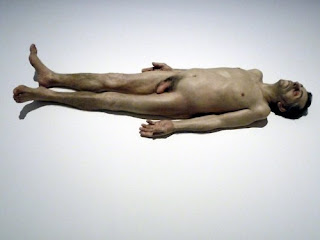1. Mueck's sculpture is described as 'hyper-real'. Define the meaning of this term and explain how it is evident in his work.
Hyper-real means that a piece of art is almost exactly like what it is trying to be. This means every detail is completely correct and in proportion. Hyper-real is evident in Mueck's sculptures because his view of things isn't distorted and he tries to portray human emotion and events (birth and death) exactly how they are with nothing left out or added.
2. Mueck says he is not interested in making life size sculpture. Find out why he is more interested in working with the scale of the figure which is not life size, and mention 2 works which use scale that is either larger or smaller than life.
Mueck never worked with life sized sculptures because he felt that if the scale was changed it would be more interesting to the viewer. The audience would be compeled to think about the hyper-realism of the sculptures versus the either oversized or undersized works. This is seen in one of his sculptures 'A Girl' which is a 5 metre long baby just after birth. Which is very confronting on its own but is made more interesting by the scale. Another one of Mueck's sculptures is 'Two Woman'. This piece involves two small woman facing each other and wearing winter coats.
3. Define Renaissance Humanism , and identify which aspects of Humanism can be seen in Mueck's work. Note that the contemporary definition of Humanism is much broader than the Renaissance definition.
Renaissance Humanism refers to the time when artists were considering their work to be more focused on the human form and the individual. I think Mueck's work has aspects of Renaissance Humanism in it such as how he focuses solely on the human form and getting every detail perfect. But Mueck works more with the human emotion of the sculptures and how the audience relates or reacts to them.
4. Research and discuss one of Mueck's sculptures that you might find challenging or exciting to experience in an art gallery. Describe the work, upload an image of the work, and explain your personal response to the work. Comment on other student blogs to develop the discussion around the variety of our own personal and individual responses to art and design.
I think Mueck's 'Dead Dad' sculpture would be very jarring to experience in real life. The idea behind having a hyper-real sculpture of a dead man right in front of you would be weird. But in a sense, I like the way this piece is very provocative and really squeezes out an emotion without being to in your face about it. Although the sculpture is small, it wouldn't have to be any bigger or life-sized for the very idea of death to draw a reaction.
http://christchurchartgallery.org.nz/multimedia/audio/floor-talk/ron-mueck-a-girl/
http://sunseven.hubpages.com/hub/Awesome_Sculptures_Of_Ron_Mueck
http://christchurchartgallery.org.nz/multimedia/audio/floor-talk/ron-mueck-two-women/

Hey Ellen- about the 'Dead Dad' sculpture, I must say I agree that this would be quite an experience to see up close and personal, I think that this piece is a very gripping piece and that you wouldn't expect it to hit you emotionally until you were standing in front of it. the size of this Particular sculpture is quite clever, by being smaller than life can give you that illusion that this guy is dead and he's shrinking, not just literally but in other ways to, (for example people who knew him might be thinking less and less about him everyday, until eventually forgetting about him.) it also gives you space to think about it and what it means. so pretty much good choice Ellen, reading that section of your blog made me think.
ReplyDeleteHi Ellen, I have to say I really enjoy your explanations. You said Mueck's work is kind of Renaissance Humanism, he focuses solely on the human form and getting every detail perfect. I do agree with your idea. I believe that he tends to show every detail from every angle of human body. As a result, he shows the normal humans rather than some perfect images. What is more, I like the image you closed-“Dead Dad”. It is small size, but the “hyper-real” can clearly be seen in this work. It shows the idea of death to the realistic in front of us.
ReplyDelete